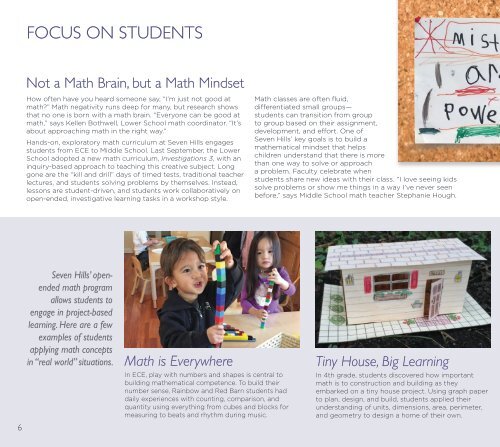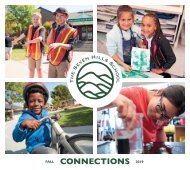Fall 2018 Connections
You also want an ePaper? Increase the reach of your titles
YUMPU automatically turns print PDFs into web optimized ePapers that Google loves.
FOCUS ON STUDENTS<br />
Not a Math Brain, but a Math Mindset<br />
How often have you heard someone say, “I’m just not good at<br />
math?” Math negativity runs deep for many, but research shows<br />
that no one is born with a math brain. “Everyone can be good at<br />
math,” says Kellen Bothwell, Lower School math coordinator. “It’s<br />
about approaching math in the right way.”<br />
Hands-on, exploratory math curriculum at Seven Hills engages<br />
students from ECE to Middle School. Last September, the Lower<br />
School adopted a new math curriculum, Investigations 3, with an<br />
inquiry-based approach to teaching this creative subject. Long<br />
gone are the “kill and drill” days of timed tests, traditional teacher<br />
lectures, and students solving problems by themselves. Instead,<br />
lessons are student-driven, and students work collaboratively on<br />
open-ended, investigative learning tasks in a workshop style.<br />
Math classes are often fluid,<br />
differentiated small groups—<br />
students can transition from group<br />
to group based on their assignment,<br />
development, and effort. One of<br />
Seven Hills’ key goals is to build a<br />
mathematical mindset that helps<br />
children understand that there is more<br />
than one way to solve or approach<br />
a problem. Faculty celebrate when<br />
students share new ideas with their class. “I love seeing kids<br />
solve problems or show me things in a way I’ve never seen<br />
before,” says Middle School math teacher Stephanie Hough.<br />
6<br />
Seven Hills’ openended<br />
math program<br />
allows students to<br />
engage in project-based<br />
learning. Here are a few<br />
examples of students<br />
applying math concepts<br />
in “real world” situations.<br />
Math is Everywhere<br />
In ECE, play with numbers and shapes is central to<br />
building mathematical competence. To build their<br />
number sense, Rainbow and Red Barn students had<br />
daily experiences with counting, comparison, and<br />
quantity using everything from cubes and blocks for<br />
measuring to beats and rhythm during music.<br />
Tiny House, Big Learning<br />
In 4th grade, students discovered how important<br />
math is to construction and building as they<br />
embarked on a tiny house project. Using graph paper<br />
to plan, design, and build, students applied their<br />
understanding of units, dimensions, area, perimeter,<br />
and geometry to design a home of their own.



